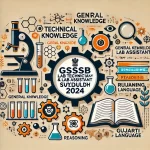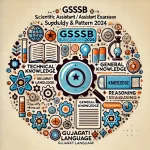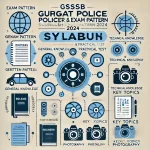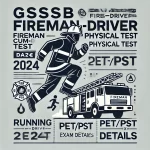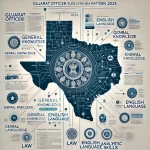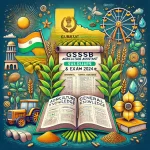Gujarat Subordinate Service Selection Board (GSSSB) will going to conducts the Fireman-cum-Driver recruitment exam in the upcoming months after physical exam to fill positions under Fire Prevention Services, Gandhinagar and Municipal Corporation. This article explains GSSSB Fireman-cum-Driver Syllabus 2024 and the its written exam pattern.
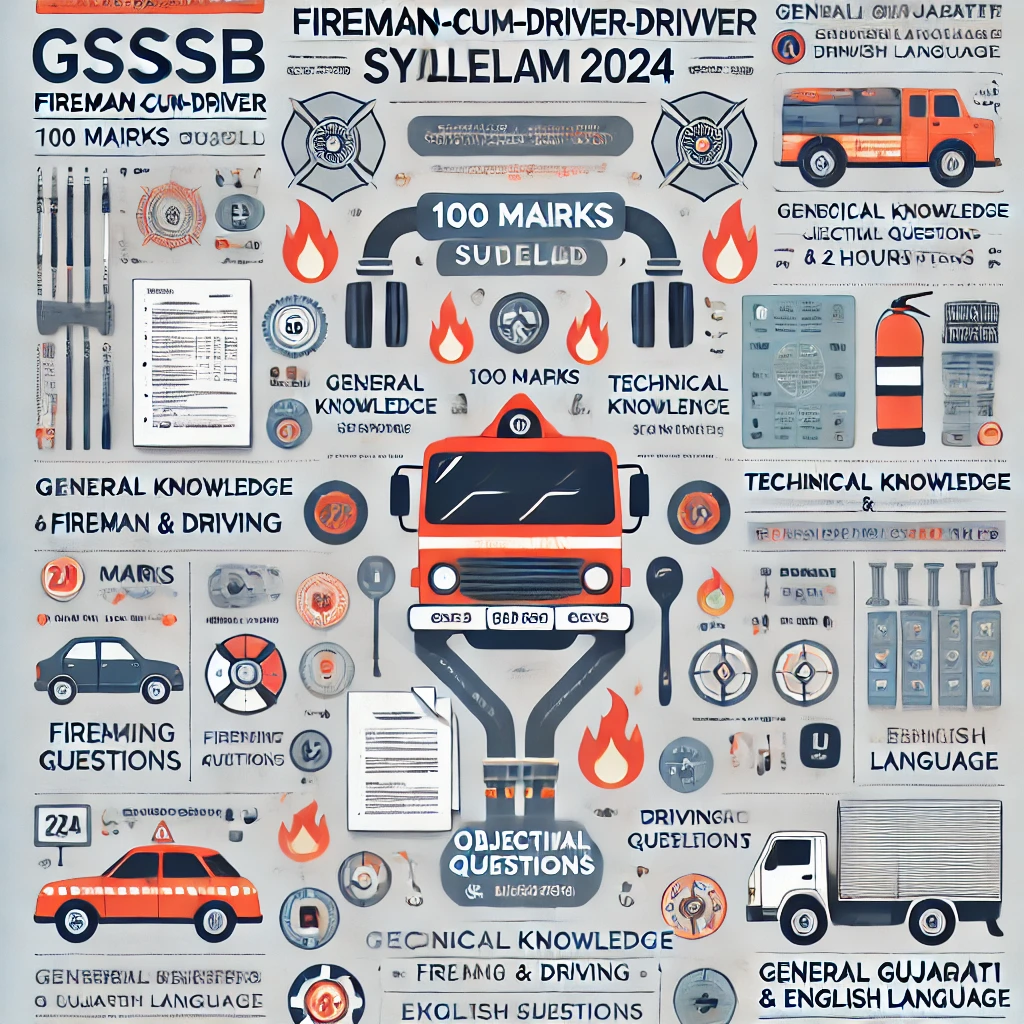
Contents
GSSSB Fireman-cum-Driver Exam Pattern 2024
The written examination for the GSSSB Fireman-cum-Driver post consists of objective-type questions and is designed to test the candidate’s knowledge in various areas essential for the role. The exam pattern generally includes the following:
Written Test:-
- Mode of Exam: Offline (pen and paper-based on OMR Sheet)
- Type of Questions: Objective Type (Multiple Choice Questions)
- Maximum Marks: 210 marks (Part A: 60 Marks Part B: 150 Marks)
- Duration: 180 Minutes (3 hours)
- Language of Paper: Gujarati and English
- Minimum Qualification Marks: 40% in Part A & 40% in Part B
Subjects Covered in the Written Test:-
- Logical Ability and Data Interpretation (30 Marks )
- Numerical Ability (30 Marks)
- Questions related to Constitution of India, Current Affairs, and Gujarati and English Comprehension. (30 Marks)
- Technical Knowledge/ Post Related Topics (120 Marks)
| Part A | Questions | Max Marks |
| Logical Ability and Data Interpretation | 30 | 30 |
| Mathematical Ability | 30 | 30 |
| TOTAL | 60 | 60 |
| Part B | ||
| Questions related to Constitution of India,
Current Affairs, Gujarati and English Comprehension |
30 | 30 |
| Subject Related Topics | 120 | 120 |
| TOTAL | 150 | 150 |
| GRAND TOTAL | 210 | 210 |
| DURATION: 3 Hours (180 Minutes) |
GSSSB Fireman-cum-Driver Syllabus 2024
The syllabus for the GSSSB Fireman-cum-Driver 2024 exam is divided into two different parts. Understanding each part is important for good exam preparation.
Reasoning and Data Interpretation (30 Questions, 30 Marks):- This section evaluates logical thinking, pattern recognition, and problem-solving abilities.
- Problems on Ages
- Venn Diagram
- Visual reasoning
- Blood relation
- Arithmetic reasoning
- Data interpretation (charts, graphs, tables)
- Data sufficiency
Mathematical/ Numerical Ability (30 Questions, 30 Marks):- To assess candidate’s knowledge of numerical ability. The topics includes:-
- Number Systems
- Simplification and Algebra
- Arithmetic and Geometric Progression
- Average
- Percentage
- Profit-Loss
- Ratio and Proportion
- Partnership
- Time and Work
- Time, Speed and Distance
- Work, Wages and chain rule
Constitution of India (10 Questions, 10 Marks):-
- Preamble of the Constitution
- Fundamental rights
- Directive principles of state policy
- Fundamental Duty
- Power, role and responsibility of President, vice president and governor
- Parliamentary system
- Amendment of Indian constitution, emergency provisions in Indian constitution
- Centre – State Government and their relation
- Judicial System of Indian Constitution
- Constitutional body
Current Affairs (10 Questions, 10 Marks):- Current events of state, national and international importance
Comprehension (Gujarati {5 marks} & English {5 marks}) (10 Questions, 10 Marks):- To assess comprehension, interpretation and inference skills in both Gujarati and English. A paragraph given with set of question on the basis of paragraph Or statement and assertion type question can be asked.
Questions and its Applications related to Technical Qualification of Fireman-cum-Driver (120 Questions, 120 Marks):-
Fireman-cum-Driver Technical Knowledge Syllabus
- Building Construction:- Introduction, Importance of Subject, Definition of Some Terms, Classification of Building, Building Material & their behaviour in fire, Importance of fire escape with respect to their positioning, construction and provisioning of firefighting measures, Fire Zones, Temporary Buildings.
- Fixed Fire Fighting Installation:- Introduction, Type of sprinklers, Type of installation, Principal of Automatic sprinkler, Testing and Maintenance, Drenchers System, Rising Mains, Hose reel, Down Comer, High Expansion foam, CO2, Halons, Automatic Fire Alarm System
- Rural Fire:- Introduction, Type of Fires, Characteristic Features, Cause of Fires in Rural Areas, Hay Stacks, Factors effecting firefighting, Appliances and equipment, Survey
- Aircraft Fire and Rescue:- Introduction, General information required in EVE Crash, General Principal of Rescue Operation, Quickest means of entrance to aircraft, After Entry in Aircraft, General principles or Fire Fighting.
- Ship Fires:- Introduction, Glossary of Shipping Terms, Passenger Ship, Cargo Ship, Large Tanker and Combination Carriers.
- Escapes:- Introduction, Elements of Escape routes, External Staircase or Fire Escapes, Spiral Fire Escape, Roof Exit, Fire Tower, Ramps, Doorways, Revolving Doors, Corridors and Passageways, Horizontal Exits, Exit Requirements, Horizontal Exit Allowance.
- Foam and Foam Making equipment:- Introduction, Area of Application, Chemical Foam, Mechanical Foam, Foam Concentrate, Types of Foam Concentrates, Storage of Foam Concentrates, Action of Work, Properties of Foam, Foam Making equipment
- Hose:- Introduction, Types of Hoses, Material Used, Non- Percolating Hose, Hose reel Hose, General Operational Misuse of Hose, Cleaning and Drying, Standard Test
- Small Gear:- Introduction, Conventional Tools, Specialized equipment, Miscellaneous Special Tools and Equipment, Lifting Equipment, Lamps and Lighting Sets.
- Ladders:- Introduction, Construction, Precautions, Maintenance, Terminology, Standard Test, Care and Maintenance, Safety Devices, Acceptance Test, Round Test.
- Pump & Pump Operation:- Introduction, Classification of Common Types in Use, Construction, Disadvantages, Advantages, Method of Priming, Testing and Fault Finding, Care and Maintenance, Standard Tests.
- Water Tender:- Introduction, Types of Water Tender, Use of Water Tender, Fire Pumps, Hose reel and Hose and its Function, Provision of a Fire way Valve and its Operation, Ladder, Spurge Pipe, Fabrication of Water Tender as per ISS 950 and Its Important features.
- Practical Fireman-ship:- Introduction, Qualification of a Good Fireman, Duty at Station Level, On way to Fire, On Reaching Fire Ground, Bringing the Fire Under Control, Ventilation, On return to station from a Fire, At Fire Ground- Practical-Fire Fighting, Finding the Fire, Signs of Building Collapse, Method of Entry, Rescue, Working in darkness, Working in Smoke, Working in an Atmosphere of inflammable gas leaking, Rescuing a man caught in electric wires.
- Hose Fittings:- Introduction, Couplings, Branches and Nozzles, Collecting Heads and Suction Hose fittings, Breechings, Adaptors, Miscellaneous Hose fitting, Hose ramps.
- Basic Physics and Chemistry:- Introduction, Combustion, Heat, Fuels, Acid, Explosion,
- Electricity:- Introduction, Fundamentals of Electricity, Generation and Distribution of Electricity, Common Causes of Electrical Fires and Remedial Measures, Static Electricity and its Hazardous.
- Hydraulics:- Introduction, Pressure and Head, Pressure and Flow, Menstruation, Nozzle Discharge, Water Requirement.
- Hydrant and Fittings:- Introduction, Water Distribution System, Type and Construction of Hydrants, Parts of Hydrants, Hydrant Gear and equipment, Marking, Testing, Care and Maintenance, Operation of Hydrants, Flow Gauges
- Water Relay:- Introduction, Method, Standard Distance between Pump and Relay, Operation, Hose laying lorry, Communication.
- Breathing Apparatus:- Introduction, Types and Parts of Breathing Apparatus, Testing and Maintenance Procedure, Care and Maintenance of Cylinder.
- Chemical Extinguishers:- Introduction, Classification of Fires, Suitability of Extinguishers for Different types of fire, Type of Fire Extinguishers, Uses, Testing, Safety Devices, Discharge Performance, Advantage and Disadvantages, Types of Dry Powder.
- First Aid & Resuscitation:- Method of approach and subsequent treatment in cases of shock, wound, burn, bleeding, fractures and respiration failures.
- Introduction, Qualities of First-Aid, Duties of First Aider, Body Parts and Systems, Injuries Encountered in Fire Incidents, Burns and Scalds, Signs and Symptoms, Management, Wounds and Haemorrhage, Bleeding and infection, Management, Fractures, Observation of Patient, Frost Bite, Snake Bite, Resuscitation.
- Watch Room Procedure:- Introduction, Constituents of Communication, Watch Room, Control Room, General Requirements, equipment, Station Ground, Turn Out Ground, Telephone Call area, Mobilising Boards, The Log or Occurrence Book, Fireless Apparatus, Handling of a Fire Call.
- Salvage:- Introduction, Equipment for Salvage Work, Method of Use, Salvage work at Fire.
- Station Administration:- Introduction, Executive Duties, Administrative Duties, Station Discipline.
- Special Services:- Introduction, Lift Rescue, Rescue from Sewers, Road and Highway Accidents, Operational Procedure, Rescue from Collapsed building, Survey, Stages of Rescue, Rescue from Well, Rescue of Animals.
- Discipline:- Introduction, Importance of Discipline, General Principle, Essentials of Disciplinarian, Outward Signs.
Important Links For Driver/Fireman Exam
- Must See: GSSSB Fireman-Cum-Driver Physical Test Date 2024 & PET PST Exam Details
- Must See: GSSSB Gujarat Police Photographer Syllabus & Exam Pattern 2024
- For Latest GSSSB Updates:- https://4syllabus.in/tag/gsssb
- For Latest Government Jobs in Gujarat:- https://4syllabus.in/tag/gujarat/
- Official GSSSB Website:- https://gsssb.gujarat.gov.in
- For Official GSSSB Fireman cum Driver Notification:- CLICK HERE
The GSSSB Fireman-cum-Driver 2024 exam has a multi-stage selection process that requires candidates to be well-versed in both academic and practical knowledge. A strong preparation strategy focused on the written exam pattern and syllabus will significantly enhance your chances of success in fireman cum driver written exam.
Additionally, maintaining physical fitness are crucial for passing physical tests in initial stages. Stay focused, practice consistently, and stay updated on current affairs to crack this fireman/driver examination.
Important FAQs
How long is the duration of the written exam?
The written exam is conducted over a duration of 3 hours.
What does the Technical Knowledge section cover?
- Fire Safety and Firefighting Equipment
- First Aid and Rescue Operations
- Motor Vehicle Rules and Traffic Laws
- Driving heavy vehicles during emergencies
What topics are covered in the General Gujarati and English Language section?
- Vocabulary: Synonyms, antonyms, idioms
- Grammar: Parts of speech, sentence structure, tenses
- Comprehension: Reading and understanding passages in both Gujarati and English
Are there any minimum qualifying marks for the written exam?
Yes, 40% in both Part A and Part B.

